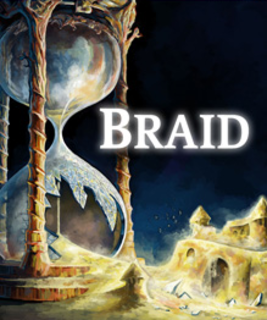A wonderful story along with fabulous gameplay mechanics make Braid one of the most laudable indie efforts ever made.
So what is Braid's story all about? Well, to reveal too much would actually kill its appeal since most of it is delivered through cryptic messages at the start of each level that have to be interpreted in order to figure out the greater message behind them. Basically you have this young man named Tim who is intent on finding the princess with whom according to the story, he had a relationship with that had a seemingly abrupt ending, and saving her from a certain monster. Most of the passages reveal things about Tim's personality as well as events from his past and the mistakes that lead to the "breakup" with the princess.
As you advance you'll notice strange references that lead you to think that all is not what it seems. What's best about the story is how by the time the ending comes, the time manipulation mechanic is deeply tied to the story. To say anything about the ending would be criminal since the ending is so brilliant that your jaw will drop at the phenomenal plot twist that's waiting to unfold. But that's not all, since hidden behind the story is a very deep message that must be carefully interpreted to figure out. Pay close attention to all the story passages as well as the epilogue (where some not so subtle references are dropped...).
As mentioned before, Braid's gameplay revolves around time manipulation. Tim starts by being able to rewind time, which in the first world helps you solve simple jumping puzzles. As you advance though, certain twists are introduced. In the second world certain elements are immune to time manipulation which means that even if you rewind time, the element won't change it's current state. For example, if you open a door that's immune to time manipulation and then rewind time, the door will remain open.
In the third world, time only moves forward or backward depending on Tim's movement. Move forward and time advances, move backwards and time rewinds. In the fourth world every time you rewind time a shadow appears that performs the same action you had previously done. Finally, in the fifth world (regular world), Tim gets a ring that when dropped slows down time within a certain radius.
The puzzles in Braid are all about taking advantage of Tim's abilities rather than precise platforming. The way puzzles are designed is simply genius. Braid is a game that will make you work your brain hard, really hard. While the puzzle solving carries a high level of difficulty, Braid never gets frustrating because the puzzles are so expertly designed that you always feel like the solution is right at your hands, you just need to think hard to figure it out. In fact, the biggest thrill in the game comes the moment you solve a puzzle, because solving each one feels like quite an accomplishment.
Each world in Braid is represented by a room in Tim's apartment. The levels in Braid are very short and you don't actually need to solve the puzzles presented in order to advance. You can wander around between different worlds as you please, which is refreshing since a particularly hard puzzle won't halt your progress, at least temporarily.
However, in order to access the final world, which is represented by Tim's attic, you need to collect all the 60 puzzle pieces scattered through the levels (which reveal different paintings related to each world). This is quite a challenge and could be mildly frustrating for some since some pieces are devilishly placed, but for the purposes of the story it works perfectly.
Talking about the technical presentation in Braid feels superfluous compared to the rest, but even in its presentation Braid is flawless. The visuals are surreal as they are backed by a marvelous art direction that makes the backgrounds look like oil paintings. Every world presents a different motif which makes them look unique and fits in with the time manipulation theme behind them. The sound however is even better. Braid's soundtrack consists of beautiful instrumental music that simply never gets old. Each track is soothing and relaxing and at times you'll stop playing simply to appreciate the wonderful music.
In case you want to know about the differences between the PC and Xbox 360 versions, there aren't any as far as content is concerned. The game can be played with both a keyboard or an Xbox 360 gamepad. Both control methods work like a charm so it's entirely up to your preferences to pick one. The one thing that the PC version does feature is a level editor. This is a great feature for those who have the patience and dedication to create a level for the game. Unfortunately there's very little documentation about how to use the editor, so you'll have to venture online in order to figure out how it works. It'll be interesting to see if the modding community can come up with some decent levels for Braid.
Braid is an experience like no other. It's living proof of the potential that lies amongst indie games and a marvelous accomplishment all things considered. It may be a short ride, but between it's delightful story and brilliant gameplay mechanics, Braid is a subliminal adventure and a perfect example of gaming as an artform.

